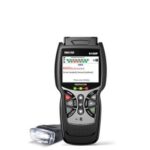Understanding the diagnostic codes from your 2014 Ford vehicle can save you time and money. The On-Board Diagnostics II (OBD2) system is designed to monitor various systems in your car and alert you to potential issues through a standardized set of codes. This article will explore what you need to know about 2014 Ford OBD2 codes, how to read them, and what the implications might be for your vehicle’s health.
Understanding OBD2 Systems in 2014 Ford Vehicles
For 2014 models, Ford vehicles are equipped with OBD2 systems, a standard across most modern cars. This system utilizes a diagnostic port, typically located under the dashboard, to communicate with your vehicle’s computer. When your car detects a problem, it generates a Diagnostic Trouble Code (DTC) which can be accessed using an OBD2 scanner.
A crucial aspect to understand in 2014 Ford vehicles, and many modern cars, is the Controller Area Network (CAN) bus system. Ford often employs two main types of CAN buses:
- High-Speed CAN (HS-CAN): This bus handles critical, real-time communication between modules like the engine control unit (ECU), transmission control unit (TCU), and often the power steering control module (PSCM).
- Medium-Speed CAN (MS-CAN): This network is used for less time-sensitive communications, often involving body control modules, infotainment systems, and other accessory functions.
The distinction is important because some diagnostic functions, especially those related to critical systems like steering or engine management, might reside on the HS-CAN bus.
OBD2 Scanner Tools for Your 2014 Ford
To read the OBD2 codes from your 2014 Ford, you’ll need an OBD2 scanner. There’s a wide range of scanners available, from basic handheld devices to more advanced professional tools.
-
Basic OBD2 Scanners: These are often inexpensive and readily available at auto parts stores. They are designed to read generic OBD2 codes, which are standardized across manufacturers. While useful for basic issues, they may have limitations. As noted in some experiences, entry-level scanners might not be very effective in all situations.
-
ELM327 Scanners: A popular type of affordable scanner utilizes the ELM327 chip. These scanners connect to your OBD2 port and communicate via Bluetooth or USB to a smartphone, tablet, or laptop. They can read OBD2 codes and often offer additional features like live data monitoring. Most ELM327 scanners are designed to communicate on the HS-CAN bus, which is sufficient for many common diagnostic needs.
-
Professional Diagnostic Tools: Dealerships and professional mechanics use advanced diagnostic tools that offer deeper access to vehicle systems. These tools can often read manufacturer-specific codes beyond the generic OBD2 codes and may have capabilities to communicate on both HS-CAN and MS-CAN buses. While more expensive, they provide a more comprehensive diagnostic capability.
Navigating CAN Bus Limitations and Advanced Diagnostics
A key point to be aware of is that standard, low-cost OBD2 readers, especially ELM327 based ones, typically communicate on the HS-CAN bus. While this covers many essential systems, some modules in your 2014 Ford, like certain body control functions or specific accessory modules, might be on the MS-CAN bus.
If you suspect an issue with a system that might be on the MS-CAN bus, a standard OBD2 scanner might not be able to access those specific codes. In such cases, you have a few options:
-
Dealership Diagnostic Service: Ford dealerships have the equipment and expertise to diagnose issues across all vehicle systems, including both CAN bus networks. However, this service usually comes at a higher cost.
-
Advanced Scanners with MS-CAN Support: Some aftermarket scanners are designed to communicate on both HS-CAN and MS-CAN buses. These scanners might be more expensive than basic OBD2 readers but offer broader diagnostic coverage. It’s important to check the specifications of a scanner to confirm MS-CAN compatibility if you suspect you need to access modules on that network.
-
Modified ELM327 Adapters: For advanced users, there are modifications and adapters that can be used with ELM327 scanners to access the MS-CAN bus. These often involve using a switch or specialized cables to route the scanner’s communication to the correct pins on the OBD2 connector. However, these modifications require technical knowledge and should be approached with caution.
Conclusion: Empowering Your 2014 Ford Diagnostics
Understanding OBD2 codes in your 2014 Ford is a valuable skill for any car owner. While basic OBD2 scanners are useful for many common issues, being aware of the CAN bus system and potential limitations is crucial for comprehensive diagnostics. For complex problems or issues that might involve the MS-CAN bus, seeking professional diagnostic services or using advanced scanning tools may be necessary to ensure accurate troubleshooting and repair of your 2014 Ford vehicle.
